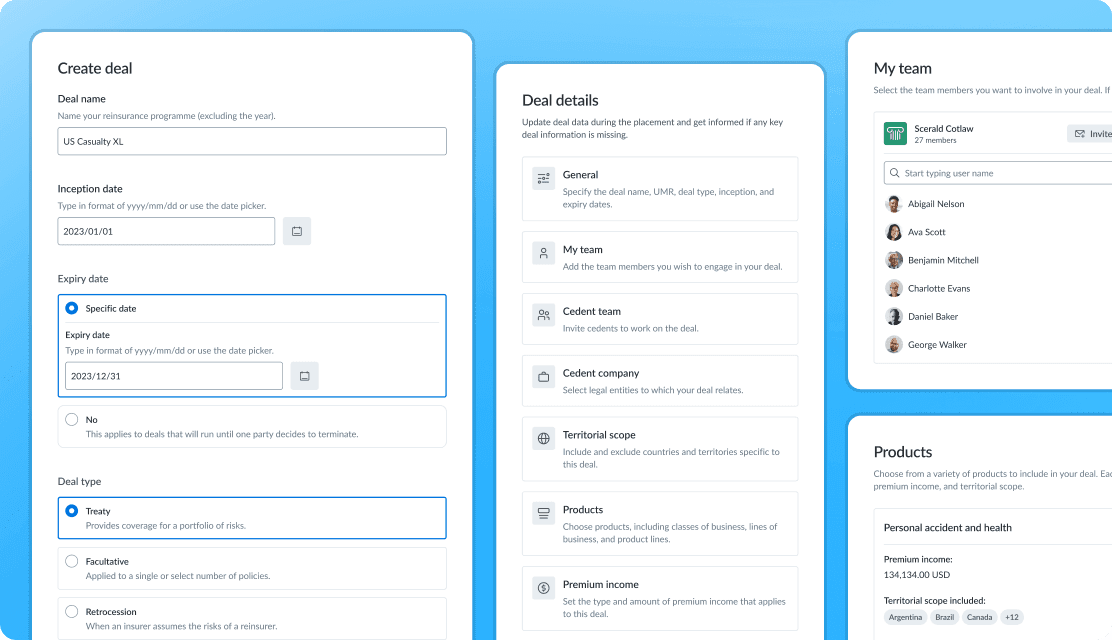/
Case study
Enabling scalable reinsurance data sharing
I led the design and partnered with Product and Engineering to shape a brand-new initiative related to on-platform data-sharing capabilities between cedents and brokers. I co-organized and facilitated research to validate our assumptions, prototyped interactions, and designed the full experience integrated into core flows.
Success metrics:
Problem
In reinsurance, a "pack" is a dataset used by cedents, brokers, and underwriters to price reinsurance. The industry's standard practice is to share the pack containing sensitive information like names and postal codes using email or FTP, which is neither convenient nor secure.
Cedent companies often work with multiple brokers and reinsurers, necessitating the creation of numerous versions of nearly identical data files for different partners. Even minor changes to the original data require updating all versions and notifying everyone involved.
As a reinsurance platform aiming to connect cedents and brokers and create an ecosystem for the market, Supercede was missing a crucial component: a way to exchange reinsurance data between users. Without this feature, the platform felt like a set of disjointed features rather than a complete end-to-end solution.
Challenge
To address this gap, we planned to enable cedents to share their data stored on the platform with brokers, and later with reinsurers. Success would be measured by the >30% Feature Adoption Rate and >50% Active User Adoption Rate within the half-year.
Supercede aimed to grow its customer base by encouraging cedents and brokers to invite their business partners to the platform. The goal was to streamline data exchange by encouraging cedents to invite brokers to share data with them, while also enabling brokers to invite cedents to receive data from them, creating a mutually beneficial network.
Kickoff. Picking up the pieces
As it was a brand-new initiative, I had to learn a lot to understand users’ current experiences better and build a clear vision of their needs. To fill the gaps, I decided to interview stakeholders and users and conduct a contextual inquiry with them remotely.
Interviewing and observing cedents and brokers allowed me to learn about their existing challenges regarding data management. Engaging with stakeholders from the Customer Success and Sales departments helped me to learn more about existing and potential clients’ expectations regarding data sharing. It provided KPIs to measure success from a business perspective.
Uncovering needs
Synthesizing the data into actionable insights revealed the following needs:
Cedents:
Share pack data (exhibits and supporting docs) or parts of it with multiple partners.
Anonymize sensitive information, such as insured names, postal codes, and claimant names during the sharing.
Edit or revoke partner access to data.
Brokers:
Download all shared pack data.
Manage team permissions (grant access to other brokers within their company).
Build localized profiles and view reports.
Behavioral metrics & KPIs
From the user perspective, we wanted to measure success by tracking the Task Success Rate, Time on Task, Error Rate, and the number of requests to the customer support department.
From a business perspective, we wanted to ensure we could track Customer Satisfaction and Effort Scores and the number of packs shared.
To-be user flow
Mapping the new flow allowed me to align with stakeholders and some of the clients.
Wireframing (data import interactions)
Sketching out a rapid solution helped me explore different alternatives and gather feedback from the stakeholders and users. It also demonstrated what interface elements would exist on key pages and helped map the interactions.

Prototyping (UI)
I developed an interactive prototype for the data-sharing flow using existing components and Figma’s prototyping capabilities for early-stage usability testing. Later on, we built a coded prototype for more detailed testing.
Easy access to data-sharing
Users have quick access to the new feature from the right sidebar on the Pack page.
Selecting broker company
Cedents specify the broker company with which they want to share the Pack. If the company isn’t listed on the platform, they can use an alternative flow to invite organization members on Supercede and share the Pack with them.
Specifying broker team
For organizations with over 50 members, a two-column layout makes it easy to manage team members.
Granting exhibit data access
Cedents can precisely define what data from the Pack the broker will have access to. They can also anonymize sensitive information like insured names and claimants.
Giving access to files
Cedents choose which Pack files the broker team can access.
Permissions management
The 'Shared with' page lists companies with Pack access. Cedents can adjust data settings for each company or revoke access anytime.
Design system
Using components with Figma color variables applied, all designs are available in light and dark themes out of the box, improving flexibility and user experience.
Rollout and adoption
We tested the new data import feature with a limited number of users and then presented it as a beta version for all the clients. All the training and support materials were created in advance and published in the company’s knowledge base.
Impact
Introducing on-platform data sharing unlocked cooperation between cedents and brokers/reinsurers on Supercede, receiving positive user feedback. The new data-sharing experience is now widely used by Supercede clients and has become one of the key factors in the product's long-term growth.
Success metrics:
34%
Feature Adoption
62%
Active User Adoption
For confidentiality reasons, I have omitted the actual values for the metrics.










